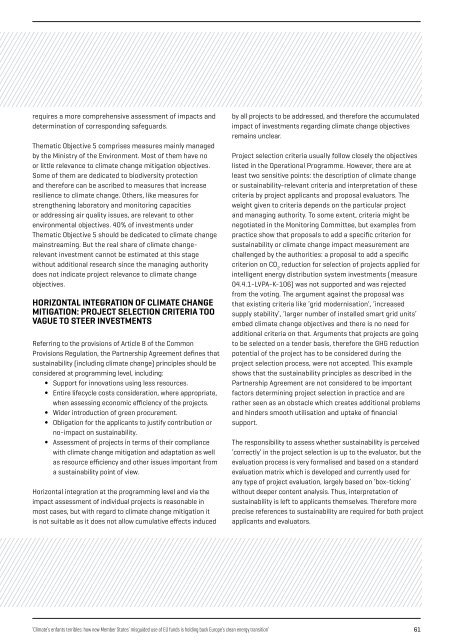ENFANTS TERRIBLES
enfants-terribles
enfants-terribles
You also want an ePaper? Increase the reach of your titles
YUMPU automatically turns print PDFs into web optimized ePapers that Google loves.
equires a more comprehensive assessment of impacts and<br />
determination of corresponding safeguards.<br />
Thematic Objective 5 comprises measures mainly managed<br />
by the Ministry of the Environment. Most of them have no<br />
or little relevance to climate change mitigation objectives.<br />
Some of them are dedicated to biodiversity protection<br />
and therefore can be ascribed to measures that increase<br />
resilience to climate change. Others, like measures for<br />
strengthening laboratory and monitoring capacities<br />
or addressing air quality issues, are relevant to other<br />
environmental objectives. 40% of investments under<br />
Thematic Objective 5 should be dedicated to climate change<br />
mainstreaming. But the real share of climate changerelevant<br />
investment cannot be estimated at this stage<br />
without additional research since the managing authority<br />
does not indicate project relevance to climate change<br />
objectives.<br />
HORIZONTAL INTEGRATION OF CLIMATE CHANGE<br />
MITIGATION: PROJECT SELECTION CRITERIA TOO<br />
VAGUE TO STEER INVESTMENTS<br />
Referring to the provisions of Article 8 of the Common<br />
Provisions Regulation, the Partnership Agreement defines that<br />
sustainability (including climate change) principles should be<br />
considered at programming level, including:<br />
• Support for innovations using less resources.<br />
• Entire lifecycle costs consideration, where appropriate,<br />
when assessing economic efficiency of the projects.<br />
• Wider introduction of green procurement.<br />
• Obligation for the applicants to justify contribution or<br />
no-impact on sustainability.<br />
• Assessment of projects in terms of their compliance<br />
with climate change mitigation and adaptation as well<br />
as resource efficiency and other issues important from<br />
a sustainability point of view.<br />
Horizontal integration at the programming level and via the<br />
impact assessment of individual projects is reasonable in<br />
most cases, but with regard to climate change mitigation it<br />
is not suitable as it does not allow cumulative effects induced<br />
by all projects to be addressed, and therefore the accumulated<br />
impact of investments regarding climate change objectives<br />
remains unclear.<br />
Project selection criteria usually follow closely the objectives<br />
listed in the Operational Programme. However, there are at<br />
least two sensitive points: the description of climate change<br />
or sustainability-relevant criteria and interpretation of these<br />
criteria by project applicants and proposal evaluators. The<br />
weight given to criteria depends on the particular project<br />
and managing authority. To some extent, criteria might be<br />
negotiated in the Monitoring Committee, but examples from<br />
practice show that proposals to add a specific criterion for<br />
sustainability or climate change impact measurement are<br />
challenged by the authorities: a proposal to add a specific<br />
criterion on CO 2<br />
reduction for selection of projects applied for<br />
intelligent energy distribution system investments (measure<br />
04.4.1-LVPA-K-106) was not supported and was rejected<br />
from the voting. The argument against the proposal was<br />
that existing criteria like ‘grid modernisation’, ‘increased<br />
supply stability’, ‘larger number of installed smart grid units’<br />
embed climate change objectives and there is no need for<br />
additional criteria on that. Arguments that projects are going<br />
to be selected on a tender basis, therefore the GHG reduction<br />
potential of the project has to be considered during the<br />
project selection process, were not accepted. This example<br />
shows that the sustainability principles as described in the<br />
Partnership Agreement are not considered to be important<br />
factors determining project selection in practice and are<br />
rather seen as an obstacle which creates additional problems<br />
and hinders smooth utilisation and uptake of financial<br />
support.<br />
The responsibility to assess whether sustainability is perceived<br />
‘correctly’ in the project selection is up to the evaluator, but the<br />
evaluation process is very formalised and based on a standard<br />
evaluation matrix which is developed and currently used for<br />
any type of project evaluation, largely based on ‘box-ticking’<br />
without deeper content analysis. Thus, interpretation of<br />
sustainability is left to applicants themselves. Therefore more<br />
precise references to sustainability are required for both project<br />
applicants and evaluators.<br />
‘Climate’s enfants terribles: how new Member States’ misguided use of EU funds is holding back Europe’s clean energy transition’ 61


